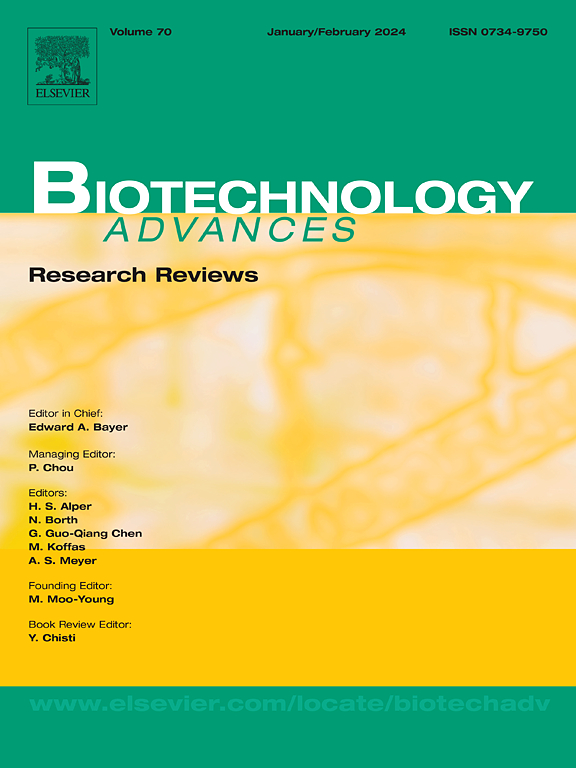利用瘤胃微生物将木质纤维素生物质转化为挥发性脂肪酸的研究进展
IF 12.5
1区 工程技术
Q1 BIOTECHNOLOGY & APPLIED MICROBIOLOGY
引用次数: 0
摘要
木质纤维素生物质是化石燃料的一种可能的替代品,因为它的广泛可用性和许多好处。挥发性脂肪酸(VFAs)是重要的中间体,可以转化为生物燃料或化学品。通过厌氧发酵从木质纤维素生物质中生产VFA是一种有前途的资源利用方法。然而,木质纤维素生物质的高结晶度和复杂的结构限制了其水解,从而影响了VFA的生产。瘤胃微生物可以有效地分解纤维素和半纤维素,在木质纤维素降解中具有明显的优势。近年来,RMs已被用作降解木质纤维素生物质生产VFAs的有效接种物。因此,有必要对木质纤维素生物质通过RMs厌氧发酵生产VFA进行综述。迄今为止,影响VFA生产的主要因素、VFA生产的新型反应器设计以及提高VFA生产的主要策略尚未得到综述。本文综述了木质纤维素转化为VFAs的主要酶、水解酶和代谢途径。综述了近年来木质纤维素发酵制备VFAs的研究进展及其影响因素。此外,还探讨了VFA产量的提高策略和VFA的回收方法。最后,介绍了目前木质纤维素生物质发酵生产VFAs的挑战和前景。这篇综述为利用rmm从木质纤维素生物质中高效生产VFA提供了见解和方法。本文章由计算机程序翻译,如有差异,请以英文原文为准。
Recent advances in bioconversion of lignocellulosic biomass for volatile fatty acid production with rumen microorganisms
Lignocellulosic biomass is a possible alternative for fossil fuels due to its widespread availability and numerous benefits. Volatile fatty acids (VFAs) are important intermediates that can be converted into biofuels or chemicals. VFA production from lignocellulosic biomass via anaerobic fermentation is a promising approach for resource utilization. However, the high crystallinity and complex structure of lignocellulosic biomass limit its hydrolysis, thereby affecting VFA production. Rumen microorganisms (RMs) can efficiently break down cellulose and hemicellulose, offering distinct advantages during lignocellulose degradation. Recently, RMs have been used as an efficient inoculum for degrading lignocellulosic biomass to produce VFAs. Therefore, a review of VFA production from lignocellulosic biomass via anaerobic fermentation with RMs is necessary. To date, main factors affecting VFA production, novel reactor designs for VFA production, and main strategies enhancing VFA production have not been reviewed. In this review, the key RMs, hydrolases, and metabolic pathways involved in the conversion of lignocellulose into VFAs are analyzed. Recent advancements regarding the fermentation of lignocellulose to produce VFAs by RMs and the key factors involved are summarized. Moreover, enhancement strategies for VFA production and recovery methods for VFAs are explored. Finally, the current challenges and prospects for the fermentation of lignocellulosic biomass to produce VFAs by RMs are presented. This review offers insights and approaches for efficient VFA production from lignocellulosic biomass using RMs.
求助全文
通过发布文献求助,成功后即可免费获取论文全文。
去求助
来源期刊

Biotechnology advances
工程技术-生物工程与应用微生物
CiteScore
25.50
自引率
2.50%
发文量
167
审稿时长
37 days
期刊介绍:
Biotechnology Advances is a comprehensive review journal that covers all aspects of the multidisciplinary field of biotechnology. The journal focuses on biotechnology principles and their applications in various industries, agriculture, medicine, environmental concerns, and regulatory issues. It publishes authoritative articles that highlight current developments and future trends in the field of biotechnology. The journal invites submissions of manuscripts that are relevant and appropriate. It targets a wide audience, including scientists, engineers, students, instructors, researchers, practitioners, managers, governments, and other stakeholders in the field. Additionally, special issues are published based on selected presentations from recent relevant conferences in collaboration with the organizations hosting those conferences.
 求助内容:
求助内容: 应助结果提醒方式:
应助结果提醒方式:


